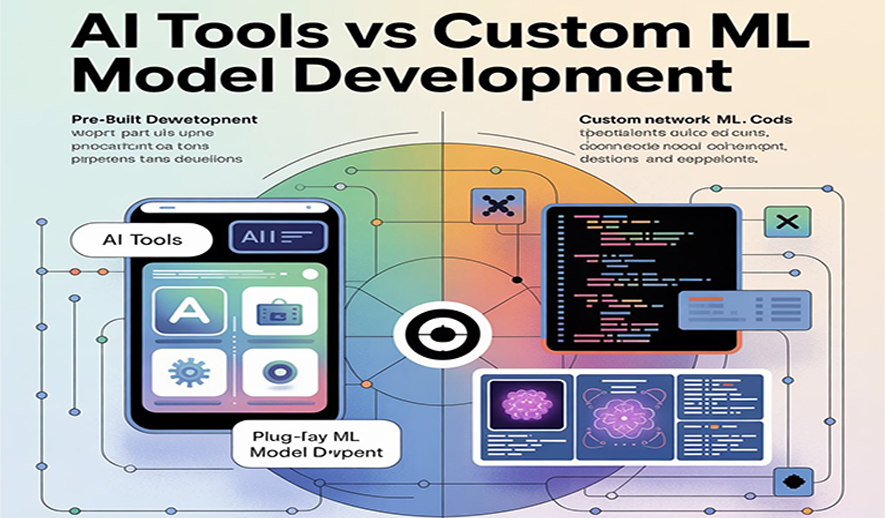
AI Tools vs Custom ML Model Development
An organization's choice between using AI tools and developing custom machine learning (ML) models is a strategic decision that depends on its specific goals, resources, data, and timeline. AI tools, or "off-the-shelf" solutions, offer a faster, more accessible, and more cost-effective entry into AI. Custom ML model development is a longer-term investment that provides greater control, accuracy, and differentiation for niche or complex problems.
AI tools: The build-it-yourself and buy-it-now approach
AI tools include pre-built models, low-code platforms, and APIs offered by vendors like Google, Amazon, and OpenAI.
Advantages of AI tools
- Rapid deployment: You can quickly implement AI capabilities in days or weeks using pre-packaged solutions or easy-to-use platforms.
- Lower upfront costs: Instead of investing in a specialized team and infrastructure, you typically pay a subscription or usage fee, which is more accessible for smaller budgets.
- Reduced expertise needed: No-code ML platforms and intuitive interfaces allow non-experts, such as business analysts, to build and deploy models.
- Proven reliability: Leading providers test and maintain their off-the-shelf tools, so the technology is often reliable and backed by professional support.
- Managed upgrades: Vendors regularly update their models, ensuring your business benefits from the latest AI advancements without additional effort.
Disadvantages of AI tools
- Limited customization: Off-the-shelf solutions are built for broad use cases, so they may not perfectly align with your specific business needs or workflows.
- Data privacy and security risks: Using third-party tools may require sending sensitive data to external servers, which can be a concern for industries with strict regulations.
- Vendor lock-in: Becoming dependent on a single vendor's API or platform can limit your flexibility and scalability over time.
- Less competitive differentiation: Because off-the-shelf solutions are widely available, they offer less opportunity to gain a unique competitive advantage compared to a custom-built solution.
Custom ML model development: The strategic investment
Custom ML development involves building a model from scratch or extensively fine-tuning a base model to address a very specific business problem.
Advantages of custom ML
- Superior accuracy and performance: A custom model trained on unique, proprietary data can outperform a generic tool for niche or complex tasks.
- Competitive moat: A custom model can be a core strategic asset that is difficult for competitors to replicate, creating a unique competitive advantage.
- Full control and IP ownership: You maintain full control over the data, model architecture, and intellectual property. This is critical for data governance and compliance in regulated industries like finance and healthcare.
- Tailored functionality: The model can be precisely designed and integrated into your existing systems and workflows, maximizing its efficiency and value.
- Long-term ROI: While upfront costs are high, a custom model can be more cost-effective in the long run for high-volume use cases by eliminating ongoing vendor fees.
Disadvantages of custom ML
- Higher costs: Custom development requires a significant investment in a specialized data science team, infrastructure, and computational resources.
- Longer time-to-market: The process of data preparation, model training, and deployment can take months or even years.
- Increased project risk: There is a risk that the model may not perform as expected or that the project could fail to meet its goals. You also assume full responsibility for maintenance and updates.
- High data requirements: Training a custom model, especially a deep learning model, requires large volumes of high-quality, often labeled, data.
The hybrid approach: A balanced strategy
Many organizations adopt a hybrid strategy, combining the strengths of both approaches. They might start with an off-the-shelf tool to achieve quick results and validate a use case, then transition to a custom build for core functionality that offers a strategic advantage. Another hybrid option is to fine-tune an open-source or pre-trained model with proprietary data, which offers a middle ground between speed and customization.
